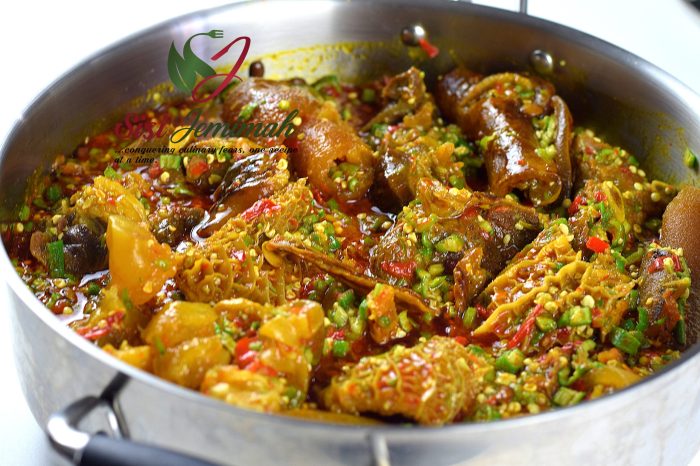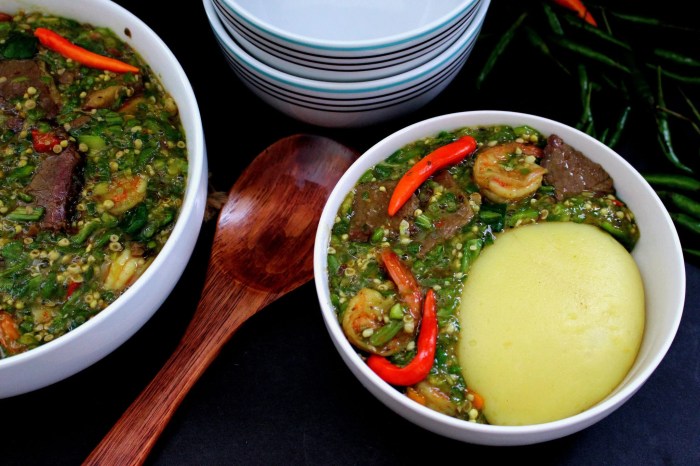Nigerian Okra Soup: A Culinary Journey
Okra soup recipe nigerian – Okra soup, a staple in Nigerian cuisine, boasts a rich history and diverse regional variations. Its cultural significance extends beyond mere sustenance, representing a vital part of Nigerian culinary heritage and social gatherings. This exploration delves into the preparation, variations, and cultural context of this beloved soup.
Introduction to Nigerian Okra Soup

Source: sisijemimah.com
Okra soup’s origins in Nigeria are intertwined with the cultivation of okra itself, a crop readily adaptable to the country’s diverse climate. While pinpointing a precise origin is difficult, its presence in Nigerian cooking predates colonial times, evolving through generations to become a cornerstone of the national culinary identity. The soup holds different cultural meanings across regions, often associated with celebrations, family gatherings, and special occasions.
For instance, in the southern regions, it might be a centerpiece of a wedding feast, while in the northern regions, it could be a comforting meal during the colder months. The variations reflect the rich diversity of Nigerian culinary traditions, showcasing the ingenuity and adaptability of Nigerian cooks.
Key Ingredients and Their Roles
A classic Nigerian okra soup recipe relies on a harmonious blend of ingredients, each contributing to its unique flavor and texture. Understanding the role of each ingredient is key to achieving the desired taste and consistency.
- Okra: The star ingredient, providing the soup’s characteristic slimy texture (though this can be controlled through preparation techniques). It also adds a subtle vegetal flavor.
- Palm oil: This provides the rich, reddish-orange color and distinctive flavor that underpins the soup’s taste. It also adds a significant amount of fat and contributes to the soup’s overall richness.
- Meat (beef, goat, fish, etc.): The protein source, contributing both flavor and nutritional value. The choice of meat significantly impacts the final taste profile.
- Seasoning (Crayfish, pepper, salt, etc.): These enhance the overall flavor and add depth to the soup. The precise blend of spices and seasonings varies across regions and individual preferences.
- Leafy Greens (Spinach, Ugu, Bitterleaf): These add color, nutritional value, and a slightly bitter counterpoint to the richness of the palm oil and meat.
| Okra Variety | Texture When Cooked | Flavor Profile | Typical Region Used |
|---|---|---|---|
| Lagos Okra | Slightly slimy, tender | Mildly vegetal, slightly sweet | Southern Nigeria |
| Abeokuta Okra | Less slimy, firmer | More vegetal, slightly earthy | Southwestern Nigeria |
| Ibadan Okra | Medium slime, good texture | Balanced vegetal and slightly sweet | Southwestern Nigeria |
Preparation Methods and Techniques
The preparation of Nigerian okra soup involves a series of steps designed to achieve the desired texture and flavor. Proper okra preparation is crucial to avoid excessive sliminess.
- Prepare the meat: Wash and cut the meat into desired sizes. Boil until tender.
- Prepare the okra: Wash and slice or chop the okra. Avoid over-chopping to maintain texture.
- Sauté aromatics: Sauté onions, pepper, and other aromatics in palm oil until fragrant.
- Add the meat broth: Add the meat broth to the sautéed aromatics.
- Simmer the soup: Add the meat and seasonings, allowing the soup to simmer for a while.
- Add the okra: Add the okra towards the end of the cooking process to prevent excessive sliminess. Stir gently.
- Add leafy greens: Add the leafy greens just before serving.
To control thickness, adjust the amount of water added. For a thicker soup, use less water; for a thinner soup, use more. Adding okra at the end of cooking helps to retain some texture and prevent excessive sliminess.
Variations and Flavor Profiles
Regional variations in Nigerian okra soup recipes are extensive, reflecting the country’s diverse culinary landscape. The choice of protein significantly alters the final flavor profile.
| Soup Variation | Key Ingredients | Distinctive Characteristics | Region |
|---|---|---|---|
| Egusi and Okra Soup | Okra, Egusi (melon) seeds, Palm oil, Meat | Nutty, rich, and slightly bitter flavor from the egusi | South-Eastern Nigeria |
| Okra Soup with Seafood | Okra, assorted seafood (fish, prawns, etc.), Palm oil, Spices | Light, refreshing, with a distinct seafood flavor | Coastal regions |
| Okra Soup with Goat Meat | Okra, Goat meat, Palm oil, Crayfish, Spices | Savory, robust flavor from the goat meat | Northern and Central Nigeria |
Serving Suggestions and Accompaniments, Okra soup recipe nigerian
Nigerian okra soup is traditionally served hot, often accompanied by various swallow foods. The serving style varies across regions, but the essence remains the same – a hearty and flavorful meal.
- Fufu: A staple accompaniment, made from pounded yam or cassava.
- Eba: A thick, starchy paste made from cassava flour.
- Amala: A yam flour-based swallow.
- Semolina: A less common but suitable alternative.
The soup is typically served in a large bowl, shared among family and friends. The traditional way involves scooping the soup and swallow with the hands, a communal and intimate dining experience.
Nutritional Information and Health Benefits
Okra soup offers a nutritious meal, rich in vitamins, minerals, and antioxidants. Okra itself is a good source of fiber, vitamin C, and vitamin K. The other ingredients contribute additional nutrients.
Regular consumption of okra soup can contribute to improved digestion, enhanced immunity, and better blood sugar control. The fiber content aids in digestion, while the vitamins and antioxidants boost the immune system. The inclusion of leafy greens further enhances the nutritional profile.
Nutritional Summary (per serving, approximate): High in fiber, vitamins A and C, moderate in protein and fat, depending on the protein source.
Visual Representation of the Recipe

Source: worldlytreat.com
A perfectly prepared bowl of Nigerian okra soup is a vibrant spectacle. The rich, reddish-orange hue of the palm oil is beautifully contrasted by the deep green of the leafy greens and the occasional flecks of meat or seafood. The texture is thick yet smooth, with a pleasant sheen from the palm oil. The aroma is warm and inviting, a captivating blend of spices, herbs, and the distinctive scent of palm oil, enriched by the savory notes of the chosen protein.
Detailed FAQs: Okra Soup Recipe Nigerian
Can I use frozen okra?
Yes, frozen okra works well. Thaw it completely before using and be mindful it may release more liquid during cooking.
What if my okra soup is too thin?
Add a slurry of cornstarch or pounded yam to thicken the soup. Simmer until desired consistency is reached.
What are some vegetarian/vegan alternatives?
Replace meat with mushrooms, spinach, or other vegetables for a hearty vegetarian or vegan version. Ensure you use vegetable broth instead of meat stock.
How long can I store leftover okra soup?
Store leftovers in an airtight container in the refrigerator for up to 3 days.
